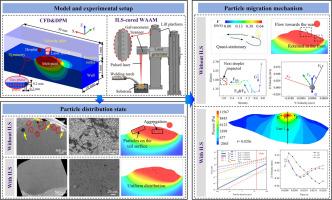Particle migration mechanisms in in-situ laser shock assisted cored-wire WAAM
IF 9.4
1区 工程技术
Q1 ENGINEERING, MECHANICAL
International Journal of Mechanical Sciences
Pub Date : 2025-09-10
DOI:10.1016/j.ijmecsci.2025.110824
引用次数: 0
Abstract
In-situ laser shock (ILS) technology pioneers a novel strategy to combat particle inhomogeneity, specifically low-density particle floating-aggregation, in cored-wire arc additive manufacturing (CWAAM). However, a critical knowledge gap persists regarding the real-time particle migration, ILS-induced melt pool dynamics, and the fundamental mechanisms by which ILS suppresses flotation, hindering its advancement. To address this, we developed a sophisticated 3D transient multiphysics model integrating heat-mass transfer, fluid flow, and particle dynamics. This model uniquely elucidates the flotation-agglomeration mechanisms of low-density particles and reveals the underlying principles of ILS suppression. The results indicate that the Stokes number for most particles ranges between 0 and 0.1, signifying predominant entrainment by liquid flow. In the absence of ILS, the combined action of Marangoni convection and buoyancy forces drives particle migration towards the upper region, inducing agglomeration. Concurrently, high-speed flow entrains particles at the rear surface of melt pool. Furthermore, the drag force plays a critical role in particle motion, exhibiting dependence on the relative velocity between the fluid and particles. The application of ILS fundamentally alters the melt pool's flow field morphology. The formation of a multi-vortex flow field and the shift of high-velocity regions effectively suppress agglomeration, increasing the coefficient of variation for particle distribution by 23 %. Simultaneously, the reverse pressure (up to 11.57 kPa) generated by the pulsed laser effectively counteracts buoyancy-induced flotation, promoting downward particle movement. During this process, an equilibrium state occurs when the relative particle-fluid velocity is lower, whereby buoyancy, gravitational force, and drag force mutually counteract. At higher relative velocities, drag force predominance still facilitate particle ascent. This investigation into particle migration behaviour in CWAAM provides a significant theoretical foundation for the further development of WAAM technology.

原位激光冲击辅助芯线WAAM中的粒子迁移机制
原位激光冲击(ILS)技术在芯线电弧增材制造(CWAAM)中率先提出了一种解决颗粒不均匀性的新策略,特别是低密度颗粒漂浮聚集。然而,关于实时颗粒迁移、ILS诱导的熔池动力学以及ILS抑制浮选的基本机制的关键知识差距仍然存在,阻碍了该技术的发展。为了解决这个问题,我们开发了一个复杂的3D瞬态多物理场模型,集成了热-质传递、流体流动和粒子动力学。该模型独特地阐明了低密度颗粒的浮选-团聚机制,揭示了抑制ILS的基本原理。结果表明,大多数颗粒的Stokes数在0 ~ 0.1之间,主要是流体夹带。在无ILS的情况下,马兰戈尼对流和浮力的共同作用驱动粒子向上层区域迁移,从而引起团聚。同时,高速流动在熔池后表面夹带颗粒。此外,阻力在颗粒运动中起着关键作用,表现出与流体和颗粒之间的相对速度有关。ILS的应用从根本上改变了熔池的流场形态。多涡流场的形成和高速区域的移动有效地抑制了团聚,使颗粒分布的变异系数提高了23%。同时,脉冲激光产生的反向压力(最大可达11.57 kPa)有效抵消浮力诱导的浮选作用,促进颗粒向下运动。在此过程中,当颗粒-流体相对速度较低时,浮力、重力和阻力相互抵消,达到平衡状态。在较高的相对速度下,阻力优势仍然有利于颗粒上升。该研究为进一步发展WAAM技术提供了重要的理论基础。
本文章由计算机程序翻译,如有差异,请以英文原文为准。
求助全文
约1分钟内获得全文
求助全文
来源期刊

International Journal of Mechanical Sciences
工程技术-工程:机械
CiteScore
12.80
自引率
17.80%
发文量
769
审稿时长
19 days
期刊介绍:
The International Journal of Mechanical Sciences (IJMS) serves as a global platform for the publication and dissemination of original research that contributes to a deeper scientific understanding of the fundamental disciplines within mechanical, civil, and material engineering.
The primary focus of IJMS is to showcase innovative and ground-breaking work that utilizes analytical and computational modeling techniques, such as Finite Element Method (FEM), Boundary Element Method (BEM), and mesh-free methods, among others. These modeling methods are applied to diverse fields including rigid-body mechanics (e.g., dynamics, vibration, stability), structural mechanics, metal forming, advanced materials (e.g., metals, composites, cellular, smart) behavior and applications, impact mechanics, strain localization, and other nonlinear effects (e.g., large deflections, plasticity, fracture).
Additionally, IJMS covers the realms of fluid mechanics (both external and internal flows), tribology, thermodynamics, and materials processing. These subjects collectively form the core of the journal's content.
In summary, IJMS provides a prestigious platform for researchers to present their original contributions, shedding light on analytical and computational modeling methods in various areas of mechanical engineering, as well as exploring the behavior and application of advanced materials, fluid mechanics, thermodynamics, and materials processing.
 求助内容:
求助内容: 应助结果提醒方式:
应助结果提醒方式:


